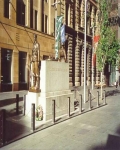Sydney Cenotaph
Archaeology »
Archaeological Monuments » Sydney Cenotaph
Sydney Cenotaph - Australia
Sydney Cenotaph is located in Sydney.
Sydney Cenotaph monument was established on 1927.
Primary threats to Sydney Cenotaph :
It is used on a regular basis for ceremonies, far more than the Australian War Memorial in Canberra. The Cenotaph is the centre for the Anzac and Armistice Day dawn service ceremonies held Sydney, regularly drawing thousands of attendees.
Historical facts of Sydney Cenotaph :
- Introduction :
The Sydney Cenotaph Monument, located in the heart of Sydney, Australia, stands as a symbol of reverence and gratitude to the brave men and women who made the ultimate sacrifice during World War I. Established in 1927, this historical landmark serves as a poignant reminder of the horrors of war and the enduring spirit of a nation. With its rich history and significance, the Sydney Cenotaph Monument holds a special place in the hearts of Australians and visitors alike.
- Historical Background :
The origins of the Sydney Cenotaph Monument can be traced back to the aftermath of World War I (1914-1918). As the war drew to a close, and the devastating impact on Australia became evident, the nation sought to commemorate the sacrifices of its servicemen and women who fought gallantly on foreign shores.
- The idea for a cenotaph, which means an empty tomb or monument in honor of those whose remains are elsewhere, gained momentum across the country. In Sydney, the New South Wales Government decided to create a grand memorial that would stand in Martin Place, one of the city's central locations.
- Design and Construction :
The architectural honor of designing the Sydney Cenotaph Monument was bestowed upon Charles Bruce Dellit, an accomplished architect who embraced the principles of classicism. His design reflected the prevailing architectural style of the time, blending neoclassical and Art Deco influences to create a structure that exuded elegance and solemnity.
- The monument comprises a series of ascending pedestals leading to the main cenotaph itself. At the top stands a heroic, bronze figure of a soldier, sculpted by Rayner Hoff. The soldier is depicted standing tall, head bowed, with arms reversed – a symbol of respect and mourning in military traditions. Surrounding the central figure, intricate bas-relief panels pay tribute to different branches of the armed forces and various aspects of wartime experiences.
- Inauguration and Unveiling :
The Sydney Cenotaph Monument was officially inaugurated on 25th April 1927. This date holds particular significance as it marks the ANZAC Day, a national day of remembrance in Australia and New Zealand, honoring the soldiers of the Australian and New Zealand Army Corps who fought in the Gallipoli Campaign during World War I.
- The unveiling of the monument was an emotional and moving event, attended by thousands of people who gathered to pay their respects. The dignified ceremony included speeches, prayers, and wreath-laying ceremonies, and it solidified the cenotaph's role as a sacred space for remembering and honoring the fallen.
- Evolution of Commemoration :
Over the years, the Sydney Cenotaph Monument has evolved to encompass remembrance of those who lost their lives in subsequent conflicts, including World War II, the Korean War, and other military engagements. The names of servicemen and women from New South Wales who perished in these conflicts were added to the monument, further emphasizing its role as a site of national significance.
- In 1984, the cenotaph underwent a significant restoration to preserve its architectural integrity and historical importance. The restoration not only addressed wear and tear but also ensured that the monument remained a powerful symbol of sacrifice for generations to come.
- Symbol of National Identity :
The Sydney Cenotaph Monument has become an integral part of Australia's national identity. It serves as a gathering point for significant events such as ANZAC Day, Remembrance Day, and other military commemorations, attracting crowds from all walks of life who come to pay their respects and remember the fallen heroes.
- Beyond its role as a memorial, the Sydney Cenotaph has also been the site of numerous public demonstrations, celebrations, and moments of national unity. It stands as a testament to the resilience of the Australian people and a reminder of the sacrifices made to secure the freedoms and values cherished by the nation.
- Conclusion :
The Sydney Cenotaph Monument stands as an enduring symbol of Australia's gratitude to those who made the ultimate sacrifice in the service of their country. With its rich history, elegant design, and deep emotional significance, the cenotaph serves as a constant reminder of the horrors of war and the importance of honoring those who have served. As time marches on, the Sydney Cenotaph continues to be a sacred space where generations can come together to pay their respects, reflect on the past, and reaffirm the commitment to peace and unity for the future.

